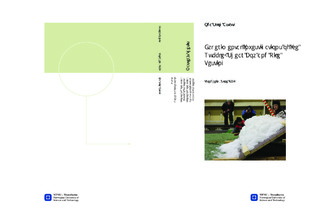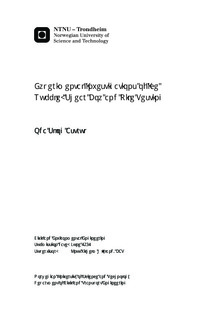| dc.contributor.advisor | Høyland, Knut Vilhelm | nb_NO |
| dc.contributor.author | Astrup, Oda Skog | nb_NO |
| dc.date.accessioned | 2014-12-19T11:29:11Z | |
| dc.date.available | 2014-12-19T11:29:11Z | |
| dc.date.created | 2012-11-08 | nb_NO |
| dc.date.issued | 2012 | nb_NO |
| dc.identifier | 566113 | nb_NO |
| dc.identifier | ntnudaim:7659 | nb_NO |
| dc.identifier.uri | http://hdl.handle.net/11250/232123 | |
| dc.description.abstract | The largest part of an ice ridge consists of unconsolidated ice rubble, whose material properties decide the load from ridges on ships and structures. Material resistance is attributed to the initial freeze-bonds and the friction and interlocking between blocks. The objective of the thesis was to investigate rubble behaviour by two tests: shear box test at NTNU and pile test at HSVA. The shear box test was aimed at investigating freeze-bond mechanisms in rubble. The pile test was aimed at suggesting values for rubble properties for a model scale experiment.The shear box had dimensions 600 mm x 400 mm x 40 mm, and was filled with ice blocks of 60 mm x 22 mm x 40 mm simulating rubble. Confinement was added, the box was submerged for 10 minutes, and tested in a rig by forcing the rubble to fail in shear. Force vs. displacement was measured. Different types of saline ice and submerging water temperatures were used. Pile testing consisted of making an elongated pyramid-shaped pile, baseline 600 mm, of rubble collected from the ice tank at HSVA. The pile was tilted and geometry was measured before and after failure happened in the pile.Main results from the shear box tests were the observation of a first phase deformation of rubble, that displayed a near linear force-displacement relation and a first peak shear stress. Magnitude of first peaks was measured in the range 8.9 kPa to 59.7 kPa, and depended on submersion water temperature, salinity of ice, how blocks were cut in respect to crystal structure in the ice sheet and confining pressure. Pile tests had repose angles ranging from 36.0° to 47.3°, and cohesion for an assumed angle of friction of 30° was in the range of 172 Pa to 342 Pa. First phase shear stress was compared to shear strength of single freeze-bond tests of the same ice, and direct relations were found. The magnitude of first peak shear stress in tests varied most with ice salinity and crystal structure. The measured repose angles for pile tests give an upper limit for internal angles of friction, and values seemed reasonable. The ice was warm, and this may the reason for the low cohesions. | nb_NO |
| dc.language | eng | nb_NO |
| dc.publisher | Institutt for bygg, anlegg og transport | nb_NO |
| dc.subject | ntnudaim:7659 | no_NO |
| dc.subject | MTBYGG Bygg- og miljøteknikk | no_NO |
| dc.subject | Marin byggteknikk | no_NO |
| dc.title | Experimental Investigations of Ice Rubble: Shear Box and Pile Testing | nb_NO |
| dc.type | Master thesis | nb_NO |
| dc.source.pagenumber | 165 | nb_NO |
| dc.contributor.department | Norges teknisk-naturvitenskapelige universitet, Fakultet for ingeniørvitenskap og teknologi, Institutt for bygg, anlegg og transport | nb_NO |

